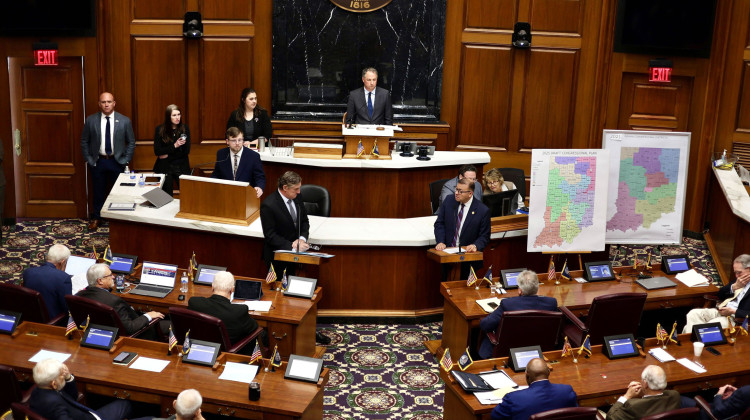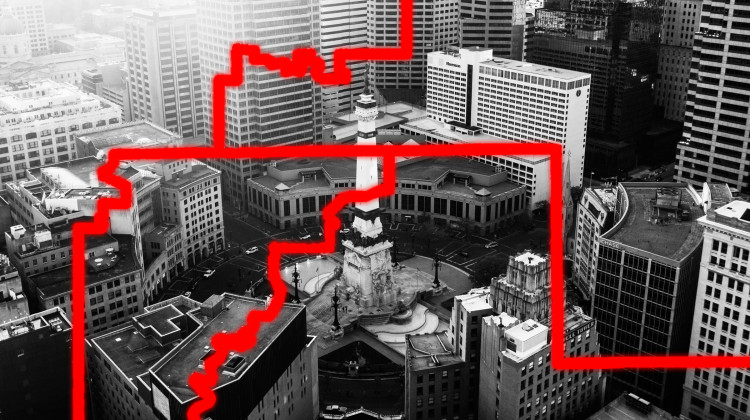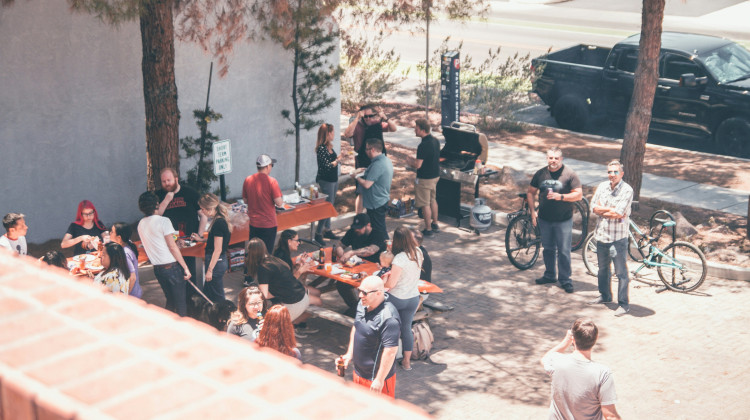This story was reported through a partnership with WFYI and IndyStar. It’s also part of The Toll – a year-long series from IndyStar about violence in the city.
Audio Story - Drew Daudelin, WFYI
Ryan Martin and James Briggs
Indianapolis Star, USA TODAY NETWORK
When the gunshots rang out on the night of June 17, India Coleman soothed her two daughters by explaining they heard fireworks on the other side of their bedroom window
Coleman knew the truth. She had been living at Towne and Terrace long enough to know what comes next.
Soon, the crime scene tape would hang above the cracked parking lot outside. The flash of red and blue lights would bounce off of the plywood bolted across door frames and windows of long-abandoned townhomes. And news cameras would roll, capturing the latest acts of violence inside a northeast-side complex home to plenty of them.
A man had been shot. Indianapolis police found the body of 35-year-old Anthony Eldridge on the floor of a boarded-up unit just a few doors down from Coleman’s townhome. His pants pockets were turned inside out, and loose change collected on the floor amid shell casings.
He wasn’t the only victim at Towne and Terrace last year. Two others were killed days apart last January, including 19-year-old Trevon Mann, whose body was dumped in a building steps away from Coleman's home.
“I’m tired of seeing dead bodies getting found out here.”
India Coleman, Towne and Terrace resident
“It’s always money. It’s always drugs. It’s always violence,” Coleman, 31, told IndyStar. “I’m tired of seeing dead bodies getting found out here.”
The carnage, the wreckage, the abandonment — it’s all become a way of life for residents living here. Situated off of 42nd Street and Post Road, Towne and Terrace brimmed with opportunity in the 1960s, promising gorgeous homes and private lawns in a first-of-its-kind community. Now, though, the complex is falling apart.
About half of the 222 units are empty or abandoned. Vinyl siding is pocked with green and black stains caused by weathering. Windows are shattered. Gutters are warped. Row after row of townhomes sit neglected, the only evidence of attention coming from the city contractors who spray-paint two numbers on units: One identifies the address, another notes the date it was last boarded up.
Towne and Terrace is a microcosm of citywide violence. Pick a systemic cause of urban bloodshed and you'll find it there: poverty, dilapidated buildings, negligent landlords, drug deals and guns.

India Coleman, a 31-year-old resident of the Towne and Terrace housing complex, sheds tears on Tuesday, Dec. 11, 2018, while talking about the violence she has seen in the years she has lived there. (Jenna Watson/The Indianapolis Star)
In partnership with WFYI-FM (90.1), IndyStar reporters spent months learning how conditions reached this low at Towne and Terrace — and what’s being done to protect the residents who live there. This story is part of IndyStar's year-long commitment to examining violence in Indianapolis.
A homeowners association appears steadfast in maintaining the status quo — and for good reason.
Three board members own at least 42 units that can fetch monthly rent around $450 per month, according to an IndyStar review of property, tax and leasing records. Two years of rental income is more than enough to pay the full value of many homes at Towne and Terrace. Clifford Courtney, an attorney representing the board, did not answer several questions posed by IndyStar after multiple phone calls and emails.
Mayor Joe Hogsett’s administration, meanwhile, insists its hands are tied. Since 2011, the city has steadily acquired about 100 properties and demolished at least 21 units across three buildings. But an ugly dispute between the city and the homeowners association — which has been playing out inside Marion Superior Court for more than five years — is stalling the city’s plans. Deputy Mayor Jeff Bennett said there’s little the city can do in the meantime
As the two sides continue battling in court, families such as Coleman’s remain captive while homes around them continue to crumble.
“Kids shouldn’t see abandoned buildings. They shouldn’t hear gunshots. They shouldn’t not be able to come out here and play,” said Coleman, who owns her unit with her husband, Marcus Milbrooks. “It’s not nowhere to live.”
La Keisha Jackson, the City-County Councilor who represents the area, is frustrated. If Towne and Terrace were picked up and dropped into another part of town, Jackson thinks this issue would have been fixed already. But not on the far east side, where she says her constituents are forgotten.
“Look at this. Look how people are living,” Jackson said during a July drive through the complex with an IndyStar reporter. “We’ve got major eyesores — health, safety, crime issues — and we can’t seem to get anything resolved with them.”
A promising start to Towne and Terrace
At one time, the phrase “look how people are living” had a different meaning there. Developer R.V. Welch Associates opened Towne and Terrace in late 1963, promoting the complex in one newspaper ad as the “most completely planned community in America.”
An IndyStar article beamed that the “kitchens are a homemaker’s dream with mapletone cabinets and modern appliances plus a built-in range and oven, food waste disposal, and refrigerator with freezing compartment, which are very popular options.” Other selling points included air conditioning, wooden fences, year-round maintenance and a new shopping center within walking distance.
Before the term rent-to-own became ubiquitous — and also code for a sometimes predatory arrangement in which ownership is technically possible, but practically unattainable — Towne and Terrace’s developer offered renters the opportunity to build equity in their homes through monthly payments.
This “leisure and private living,” as an ad described it, was available for between $49 and $79 per month, or about $400 to $640 in inflation-adjusted dollars.
Towne and Terrace, sweeping across 20 acres, offered a solidly middle-class lifestyle to families in an area teeming with jobs. Fort Benjamin Harrison in nearby Lawrence employed thousands of civilian and military personnel as an active U.S. Army training institution. Other major employers included Western Electric, Chrysler and Maytag.
The prosperity didn’t last, though. The federal government closed Fort Ben in 1991, eliminating 4,000 jobs and leaving thousands more hanging in the balance, according to IndyStar archives. Manufacturing jobs evaporated as factories shuttered. The job loss contributed to an exodus of working-class residents from the north-east side, which caused more businesses to close and forced homeowners and apartment complexes to lower their prices to attract buyers and renters.
The area around 42nd Street and Post Road became a haven for people in need of cheap housing. Property owners continued to provide the housing, yet began disinvesting in maintenance.
An October 1999 IndyStar ad listed Towne and Terrace units for sale as investment properties and reveals how quickly the complex had fallen within about 35 years. There were seven units for sale at an average price of $14,285. The median price of homes sold in the Midwest at the time was $165,100, according to U.S. Census Bureau data.
Today, units can change hands for as little as a few thousand, or even a few hundred, dollars. Meanwhile, landlords charge monthly rates that amount to the same payments people made in the 1960s when Towne and Terrace was marketed as the height of luxury living in Indianapolis.
One unit on Hampshire Court, for example, draws $575 in monthly rent, according to a copy of the lease. At that rate, the landlord can recoup the property’s entire assessed value every 14 months.
Whoever rents that Hampshire Court apartment will park in the same lot where 26-year-old Derick Daniels was gunned down while in a car last January.
Drug-dealing with near impunity
Everyone knows there’s a drug problem at Towne and Terrace.
There are big deals. Like the more than $10,000 of heroin sent in December to an unnamed person on Stratford Court, according to a federal indictment last month. That shipment was planned on behalf of a drug trafficking organization with leadership in Mexico.
And there are countless small transactions. Dealers, who might not live there but can spot an opportunity for a buck, freely hawk cocaine, marijuana and heroin in an open-air drug market tucked off of one of the courtyards. Lines of customers await their turn inside their cars.
“It’s like McDonald’s for drugs,” said IMPD Officer Jeremy Torres, who patrols the area.
“It’s like McDonald’s for drugs."
Jeremy Torres, IMPD Officer
The layout of Towne and Terrace creates a safe space for dealers to work with near impunity. A single street, Brentwood Drive, enters and exits the complex off of 42nd Street. With a lookout man stationed there, Torres said, dealers and buyers down on Stratford Court have plenty of time to scram when they start hearing the warning whistle or shouts of “5-0.”
If they even need a lookout man, that is. In one building on Essex Court — the same one where Eldridge’s body was found, close to Coleman’s home — Torres said dealers once mounted a surveillance camera aimed behind the back of houses toward the entrance on Brentwood.
With so many drugs and so much cash, dealers carry guns to protect profits.
“Most of them don’t live here but they all come, and everyone brings their guns,” Torres said. “And all it takes is a few angry words or somebody coming from a different area that they don’t agree with. Everybody just wants to solve it by shooting each other.”

IMPD officer Jeremy Torres patrols the Towne and Terrace housing complex off of 42nd Street and Post Road, on Saturday, Dec. 8, 2018. (Jenna Watson/The Indianapolis Star)
From 2008 to July 2018, IMPD dispatched officers to Towne and Terrace more than 3,500 times, according to the city’s filings in court documents.
IMPD data show at least 136 crimes occurred at Towne and Terrace between January 2013 and October 2018, the most recent date available, including at least 59 violent crimes, with about half involving guns.
Some disputes end in bloodshed. Since 2013, seven criminal homicide victims have been found at the complex.
And those numbers do not include the other terrorizing moments, such as when a neighbor hears the crackling of gunshots and an officer finds shell casings but no victim. Nor do the numbers include the regular presence of drug trafficking.
Rev. Theron Williams, pastor of nearby Mt. Carmel Church, has heard from his congregants: it’s a scary place to live.
“When the city knows how much illegal drug activity is taking place in Towne and Terrace, but acts as if it is powerless to do anything about it, it’s frustrating to me,” Williams said. “Maybe I don’t know city codes or city statutes and all that. But just a simple eye test, to me, creates frustration.”
A years-long lawsuit stops demolitions
Chloe Newman moved to Towne and Terrace in the early 1970s, a time when she recalls the complex being safe and well-maintained. She rented for a few years before buying her unit in 1980 and has lived there ever since.
The area declined following Fort Ben’s closing, but there’s someone she blames for making Towne and Terrace even worse: Walter Timmons, who is known as Glen.
Newman declined an interview request when reached by phone. But she elaborated in a court document on the evolving condition of Towne and Terrace, which she considers unrecognizable from when she moved in.
“I want to live in a safe and clean environment,” Newman wrote, “and it is my belief that Towne and Terrace Corp. has failed in helping to provide this for the last two and a half decades.”
For more than 20 years, Timmons led the homeowners association as its president, according to records filed with the state. Jackie Timmons, his wife, has held a board seat for the last nine years. Together, they owned 23 rental properties at the complex, according to property records.
They also led a resistance against the city, which ignited a legal battle that began in 2013 and continues today.
Their attorney? Clifford Courtney, the brother of Jackie Timmons. Courtney did not answer a list of questions sent to him by IndyStar. When IndyStar reached Jackie Timmons by phone, she declined to comment.
The legal arguments lobbed by each side are complicated and winding. In short, the board wants the city to fix its broken-down properties or find someone who will.
“All of the city properties are damaged and in need of immediate repairs to protect them and their adjacent and surrounding properties in Towne and Terrace,” Darren Kirkland, a board member, wrote in a June 7, 2018 affidavit.
And the city, which notes those properties are in city possession only because no one else wanted them, said it should be given the right to participate in the homeowners association. It wants to nominate new leadership.
Board directors have prevented the city from voting in annual membership meetings over the last two years. The city lost its right to vote, the board argued in court, because the city has not paid all of its fees to the homeowners association.
The city said it’s paid everything (in excess of $140,000 through 2017) and is arguing that the board is consolidating power to those on the board. That’s evident, the city said, through a new rule passed by the board that strips an owner of voting rights if that property owes any fees — even if the debt was incurred by a prior owner years ago.
“Except for the directors themselves, virtually all owners are not in good standing and have had their membership rights suspended,” the city wrote in court documents. “The conduct of (the board) toward its members is oppressive.”
Both sides are awaiting a ruling from a judge in Marion Superior Court on whether the board must allow the city to vote.
While the case continues, a judge is preventing the city from tearing down properties within the boundaries of the homeowners association, which occupies much of Towne and Terrace.
That won’t stop the city from a demolition along Brentwood Drive, outside of the boundary. The next building is set to come down in the spring.
Leadership on the board, meanwhile, has shifted to a new president. Kirkland, who owns three properties, took over in 2017.
Walter Timmons, the longtime board president, was killed Sept. 7, 2017, at 78 years old. Police found his body inside his truck in the parking lot of a payday lender, about a mile away from Towne and Terrace.
Detectives are still trying to learn who killed him.
No help for those who want to leave
Near the entrance to Towne and Terrace, people have been gathering night and day around a rusty barrel with flames roaring out of it.
Two men near the barrel talked to reporters on a recent cold and snowy afternoon. They were evasive when explaining why they were there. One man, who identified himself as Pac-Man, said he is homeless, but sleeps outside the boarded-up units. He gestured toward what appeared to be a garden and said he plans to spruce it up in the summer.
“I’m community maintenance. Put it like that,” he said.
Pac-Man described Towne and Terrace in terms that defy the reality described by police and residents. “See, what this is, it’s all about peace,” he said. “We trying to make it peace right now. All that drug stuff is out the door. It’s over with all that.”
After answering a few questions, Pac-Man looked around and appeared nervous.
“I’m gonna cut it short because all the old schools looking at me,” he said.

An unidentified man tends to a fire in front of an abandoned unit on North Brentwood Drive at the Towne and Terrace housing complex off of 42nd Street and Post Road, on Thursday, Dec. 6, 2018. According to IMPD, people who are homeless often congregate in this area near the entrance of the complex. (Jenna Watson/The Indianapolis Star)
Everyone who stays at Towne and Terrace seems to be afraid of something. In the back — far from 42nd Street, the burning barrel and most drug deals — there are families who manage to block out the turmoil around them and focus on more routine pressures of everyday life.
Shana Reid, 43, a mother of an 18-year-old son and 11-year-old daughter, has rented a home in the back portion of Towne and Terrace for three years. She tries to keep her children inside, especially at night, but feels mostly comfortable in her area.
“Back here, it’s not really bad. But up front is the worst,” Reid said. “So, long as (my children) don’t go up there and they stay back here and play, it’s fine. We can look out for them and keep an eye on them.”
Still, Reid said, she would leave Towne and Terrace if she could and flee the blight and vacant homes. She knows what it would take for her to leave, though, and she doesn’t have it.
“More money. Basically. More money,” Reid said. “But, I mean, we got to do what we got to do to survive.”
Even when families can afford to live elsewhere, the cost of moving can be prohibitive, particularly if it involves breaking a lease or walking away from a mortgage.
Reid isn’t the only person who feels trapped because of a lack of money. Even when families can afford to live elsewhere, the cost of moving can be prohibitive, particularly if it involves breaking a lease or walking away from a mortgage.
Indianapolis devotes millions of dollars per year to homelessness initiatives, but the city has no programs available to help people escape a dangerous environment such as Towne and Terrace. City officials in interviews encouraged residents to engage in the bureaucracies that so far have made little difference in their lives.
City-County Council President Vop Osili, a Democrat, said residents should report unsafe conditions to the Marion County Public Health Department and the Department of Business and Neighborhood Services, which can issue nuisance fines.
“Sometimes those citations and those liens can spur faster action,” Osili said. “It’s not always the case, especially when we have out-of-town landlords, out-of-town property owners. But they can spur an acceleration of the repair work and the maintenance work on those properties, especially when the property owners begin to see those fees mounting and they are responsible for them.”
Bennett, the deputy mayor of community development, said people who own their homes should participate in the homeowners’ association by pushing for changes such as hiring a security guard and spending more money on maintenance. Property owners at Towne and Terrace pay fees that are intended to manage and improve common areas.
“If you’re an owner-occupant, you’re a member of the HOA and I think there is an avenue for residents who are members of the HOA to affect change in how the HOA is attentive to the site’s needs,” Bennett said. “That was the whole goal of an HOA being created to begin with, to maintain on-site oversight of conditions.”
Not that either of those avenues appears to be helping much. The city has argued through years of litigation that the Towne and Terrace board has made no apparent effort to respond to the needs of the community. Any homeowner seeking to use HOA money to bring a security guard to Towne and Terrace would be petitioning the same body that has refused to include Newman on its decision-making process and shut out the city despite its ownership of 97 properties, including 71 inside the boundaries of the homeowners association.
‘Nobody can give us answers’
The city’s ability to help individual residents or demolish problem properties at Towne and Terrace is limited by the “morass of lawsuits,” Bennett said. That explanation is difficult to accept for some community leaders, who see that the city is on the precipice of claiming victory over an adjacent property.
A separate legal battle has put the city in a likely position to soon acquire and demolish the vacant Oak Tree Apartments, a complex that was condemned in 2014. In that case, the city has been fighting against a single owner, a London-based entity operating as Indy Diamond LLC.
Williams, the pastor at Mt. Carmel Church, helped rally neighborhood support for the city’s effort to demolish Oak Tree, including by organizing bus rides for people to attend a court hearing last year. With the city so close to making progress on Oak Tree, Williams is perplexed by continued suffering at Towne and Terrace and the city’s inability to overcome the small homeowners association.
“The community is well aware of what’s going on with the city’s involvement and everybody is frustrated. We don’t understand it,” Williams said. “And nobody can give us answers as to why this process has taken so long and why are you dealing with these people with kid gloves.”

The scene inside an abandoned unit on Essex Court, where the body of Anthony Eldridge was found in June 2018, at the Towne and Terrace housing complex off of 42nd Street and Post Road on Saturday, Dec. 8, 2018. (Jenna Watson/The Indianapolis Star)
Coleman is tired. After the June shooting death that left a man dead around the corner from their house, Coleman and her husband sent their daughters to live with family in Beech Grove. The girls, 10 and 7, haven’t been back to Towne and Terrace since.
Standing outside in the cold, with no coat on, she cried while discussing a choice she wishes she didn’t have to make.
“If something happened to my two daughters, I wouldn’t know what to do. I couldn’t be these parents out here that lost their kids and still be able to live on. Oh, no, I can’t do it. I can’t. Cause I lost my momma, too, so I really don’t have nobody left but my husband and my kids. That’s it. That’s the only family I have left.”
This story is published as part of The Toll, IndyStar's year-long examination of violence. Follow the project by subscribing to a weekly newsletter at indystar.com/thetoll.
Contact IndyStar reporter Ryan Martin at 317-444-6294 or ryan.martin@indystar.com. Follow him on Facebook or Twitter: @ryanmartin
Call IndyStar reporter James Briggs at 317-444-6307. Follow him on Twitter: @JamesEBriggs
 DONATE
DONATE










 Support WFYI. We can't do it without you.
Support WFYI. We can't do it without you.